Jupiter

Jupiter is the largest planet in the Solar System and contains nearly 3/4 of all planetary matter.
Physical Features
With no solid surface, Jupiter is a gas and liquid filled giant. Its turbulent belts of clouds circulate parallel to the equator and often contain oval spots which are storm systems with the largest being easily twice the diameter of Earth. The great red spot has been observed for at least 300 years and rotates counter-clockwise with wind speeds of 270 miles per hour [430 km/hr].
Explorations
Although observed and studied from Earth for centuries it wasn't until the mid 1970's that humans were able to get a closer look with the spacecraft Pioneer 10 and 11. The Voyager 1 and 2 spacecraft were launched with the specific purpose of collecting information and data on the Jovian worlds. In December 1995 the Galileo spacecraft entered into orbit and began it's long-term study of Jupiter and it's moons, a probe was also sent deep into the atmosphere of the gas giant.
Astronomy/Units|Astronomical units
Notation: let the symbol  indicate the radius of Jupiter.
indicate the radius of Jupiter.
Astrophysics
- Diameter: 142,900 km (11.2 x Earth's diameter)
- Length of Day: 9h 55m 30s
- Length of year: 11.867 years (4334.3 days)
- Average distance from the Sun: 5.2028 AU (7.783 x 108 km)
- Average orbital velocity: 13.06 km/s.
- Average Density: 1.34g/cm3
- Mass: 1.899 x 1027 kg (317.83 x Earth's Mass).
Jupiter has an equatorial radius of 71,492 ±4 km, a polar radius of 66,854 ±10 km, and a mean radius of 69,911 ± 6 km.[1]
Satellites of Jupiter
"A definite color gradient is observed [in the small inner satellites of Jupiter], with the satellites closer to Jupiter being redder: the mean violet/green ratio (0.42/0.56 μm) decreases from Thebe to Metis. This ratio also is lower for the trailing sides of Thebe and Amalthea than for their leading sides."[2]
"Io and Europa were seen for the first time as separate bodies during Galileo's observations of the Jupiter system the following day, January 8, 1610 (used as the discovery date for Io by the IAU).[3] The discovery of Io and the other Galilean satellites of Jupiter was published in Galileo's Sidereus Nuncius in March 1610.[4]"[5]
Entities
The entity Thor (also called Jupiter in some cultures) is assigned to throwing lightning bolts.
Object astronomy
"[T]he ancients’ religions and mythology speak for their knowledge of Uranus; the dynasty of gods had Uranus followed by Saturn, and the latter by Jupiter."[6]
Bands
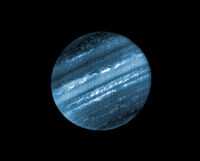
At the right is a significant observation of Jupiter in the H2O band using the Stockholm Infrared Camera (SIRCA) on the Nordic Observatory Telescope (NOT).
The image clearly shows that water vapor is plentiful in the Jovian atmosphere.
Meteors
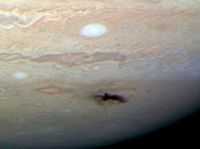

"Jupiter has been called the Solar System's vacuum cleaner,[8] because of its immense gravity well and location near the inner Solar System. It receives the most frequent comet impacts of the Solar System's planets.[9]"[10]
"A 1997 survey of historical astronomical drawings suggested that the astronomer Cassini may have recorded an impact scar in 1690. The survey determined eight other candidate observations had low or no possibilities of an impact.[11] A fireball was photographed by Voyager 1 during its Jupiter encounter in March 1979.[12] During the period July 16, 1994, to July 22, 1994, over 20 fragments from the comet Shoemaker–Levy 9 (SL9, formally designated D/1993 F2) collided with Jupiter's southern hemisphere, providing the first direct observation of a collision between two Solar System objects. This impact provided useful data on the composition of Jupiter's atmosphere.[13][14]"[10]
"On July 19, 2009, an impact site was discovered at approximately 216 degrees longitude in System 2.[15][16] This impact left behind a black spot in Jupiter's atmosphere, similar in size to Oval BA. Infrared observation showed a bright spot where the impact took place, meaning the impact warmed up the lower atmosphere in the area near Jupiter's south pole.[17]"[10]
"A fireball, smaller than the previous observed impacts, was detected on June 3, 2010, by Anthony Wesley, an amateur astronomer in Australia, and was later discovered to have been captured on video by another amateur astronomer in the Philippines.[18] Yet another fireball was seen on August 20, 2010.[19]"[10]
"On September 10, 2012, another fireball was detected.[12][20]"[10]
The second image at right shows the atmospheric impact sites for the Comet Shoemaker-Levy 9 fragments. "Spectroscopic studies revealed absorption lines in the Jovian spectrum due to diatomic sulfur (S2) and carbon disulfide (CS2), the first detection of either in Jupiter, and only the second detection of S2 in any astronomical object. Other molecules detected included ammonia (NH3) and hydrogen sulfide (H2S). The amount of sulfur implied by the quantities of these compounds was much greater than the amount that would be expected in a small cometary nucleus, showing that material from within Jupiter was being revealed."[21]
Electrons
"Field-aligned equatorial electron beams [have been] observed within Jupiter’s middle magnetosphere. ... the Jupiter equatorial electron beams are spatially and/or temporally structured (down to <20 km at auroral altitudes, or less than several minutes), with regions of intense beams intermixed with regions absent of such beams."[22]
"Jovian electrons, both at Jupiter and in the interplanetary medium near Earth, have a very hard spectrum that varies as a power law with energy (see, e.g., Mewaldt et al. 1976). This spectral character is sufficiently distinct from the much softer solar and magnetospheric electron spectra that it has been used as a spectral filter to separate Jovian electrons from other sources ... A second Jovian electron characteristic is that such electrons in the interplanetary medium tend to consist of flux increases of several days duration which recur with 27 day periodicities ... A third feature of Jovian electrons at 1 AU is that the flux increases exhibit a long-term modulation of 13 months which is the synodic period of Jupiter as viewed from Earth".[23]
X-rays
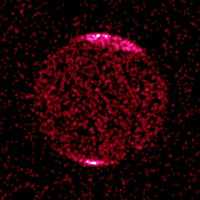

The "image of Jupiter [at right] shows concentrations of auroral X-rays near the north and south magnetic poles."[24] The Chandra X-ray Observatory accumulated X-ray counts from Jupiter for its entire 10-hour rotation on December 18, 2000. Note that X-rays from the entire globe of Jupiter are detected.
In the second at right is a diagram describing interaction with the local magnetic field. Jupiter's strong, rapidly rotating magnetic field (light blue lines in the figure) generates strong electric fields in the space around the planet. Charged particles (white dots), "trapped in Jupiter's magnetic field, are continually being accelerated (gold particles) down into the atmosphere above the polar regions, so auroras are almost always active on Jupiter. Electric voltages of about 10 million volts, and currents of 10 million amps - a hundred times greater than the most powerful lightning bolts - are required to explain the auroras at Jupiter's poles, which are a thousand times more powerful than those on Earth. On Earth, auroras are triggered by solar storms of energetic particles, which disturb Earth's magnetic field. As shown by the swept-back appearance in the illustration, gusts of particles from the Sun also distort Jupiter's magnetic field, and on occasion produce auroras."[25]
Ultraviolets
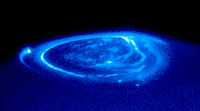
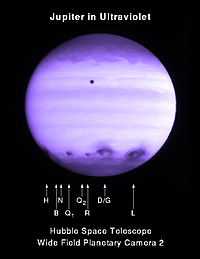
"In astronomy, very hot objects preferentially emit UV radiation (see Wien's law). Because the ozone layer blocks many UV frequencies from reaching telescopes on the surface of the Earth, most UV observations are made from space."[26]
At right is an ultraviolet image of aurora at Jupiter's north pole by the Hubble Space Telescope.
"Experiments on the Voyager 1 and 2 spacecraft and observations made by the International Ultraviolet Explorer (IUE) have provided evidence for the existence of energetic particle precipitation into the upper atmosphere of Jupiter from the magnetosphere."[27]
The image at lower right "shows Jupiter's atmosphere at a wavelength of 2550 Angstroms after many impacts by fragments of comet Shoemaker-Levy 9. The most recent impactor is fragment R which is below the center of Jupiter (third dark spot from the right). This photo was taken 3:55 EDT on July 21, about 2.5 hours after R's impact. A large dark patch from the impact of fragment H is visible rising on the morning (left) side. Proceding to the right, other dark spots were caused by impacts of fragments Q1, R, D and G (now one large spot), and L, with L covering the largest area of any seen thus far. Small dark spots from B, N, and Q2 are visible with careful inspection of the image. The spots are very dark in the ultraviolet because a large quantity of dust is being deposited high in Jupiter's stratosphere, and the dust absorbs sunlight."[28]
Visuals
"There is anecdotal evidence that people had seen the Galilean moons of Jupiter before telescopes were invented.[29]"[30]
Violets
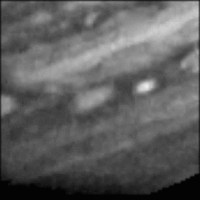

.jpg)
"This movie [at right] records an eruptive event in the southern hemisphere of Jupiter over a period of 8 Jupiter days. Prior to the event, an undistinguished oval cloud mass cruised through the turbulent atmosphere. The eruption occurs over a very short time at the very center of the cloud. The white eruptive material is swirled about by the internal wind patterns of the cloud. As a result of the eruption, the cloud then becomes a type of feature seen elsewhere on Jupiter known as "spaghetti bowls.""[31]
"As Voyager 2 approached Jupiter in 1979, it took images of the planet at regular intervals. This sequence is made from 8 images taken once every Jupiter rotation period (about 10 hours). These images were acquired in the Violet filter around May 6, 1979. The spacecraft was about 50 million kilometers from Jupiter at that time."[31]
At left is a "Voyager 1 image showing Jupiter with its satellite Io visible at lower left. Jupiter is 140,000 km in diameter and Io is 3600 km across. This image was taken with the narrow angle camera using the violet filter from a distance of 25 million km on 9 February 1979. North is at about 11:00 (Voyager 1, 15672.37)".[32]
"These images [at lower right] show the apparent edge (limb) of the planet Jupiter as seen through both the violet filter (top frame) and an infrared filter (756 nanometers, bottom frame) of the Solid State Imaging (CCD) system aboard NASA's Galileo spacecraft. North is to the top of the picture. A separate haze layer is clearly visible above the northern part of the limb."[33]
"This haze layer becomes less well defined to the south (bottom left). Such a detached haze layer has been seen previously on only one other body with a thick atmosphere: Saturn's satellite Titan. The haze layer cannot be lower in the atmosphere than a pressure of about 10 millibars (mbar), or about 40 kilometers (km) above the tropopause. (The tropopause, where the temperature stops decreasing with height, is at about 100 mbar, 20 km above the tops of the ammonia clouds.) There is some indication of streaks of slightly brighter and darker material running roughly north-south (parallel to the limb) on Jupiter's crescent."[33]
"The images, which show the limb between 60.5 degrees and 61.8 degrees North latitude (planetographic) and near 315 degrees West longitude, were obtained on December 20, 1996 Universal Time. The spacecraft was about 1,286,000 km (18.0 Jovian radii) from the limb of Jupiter and the resolution is about 13 kilometers per picture element."[33]
Blues
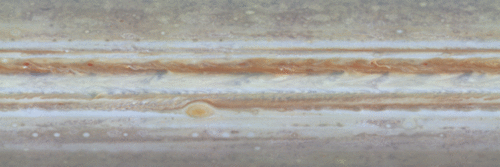
The wide equatorial zone is visible in the center surrounded by two dark equatorial belts (SEB and NEB).
"The large grayish-blue [irregular] "hot spots" at the northern edge of the white Equatorial Zone change over the course of time as they march eastward across the planet."[34]
"The Great Red Spot shows its counterclockwise rotation, and the uneven distribution of its high haze is obvious. To the east (right) of the Red Spot, oval storms, like ball bearings, roll over and pass each other. Horizontal bands adjacent to each other move at different rates. Strings of small storms rotate around northern-hemisphere ovals."[34]
"Small, very bright features appear quickly and randomly in turbulent regions, candidates for lightning storms."[34]
"The smallest visible features at the equator are about 600 kilometers (about 370 miles) across."[34]
"The clip consists of 14 unevenly spaced timesteps, each a true color cylindrical projection of the complete circumference of Jupiter, from 60 degrees south to 60 degrees north. The maps are made by first assembling mosaics of six images taken by Cassini's narrow-angle camera in the same spectral filter over the course of one Jupiter rotation and, consequently, covering the whole planet. Three such global maps -- in red, green and blue filters -- are combined to make one color map showing Jupiter during one Jovian rotation. Fourteen such maps, spanning 24 Jovian rotations at uneven time intervals comprise the movie."[34]
The passage of time is accelerated by a factor of 600,000.
Yellows
"[T]he #8 yellow filter is used to show Mars's maria and Jupiter's belts.[35]"[36]
Oranges
In the image at the top of the page, orange cloud bands are clearly visible on Jupiter.
"[O]range [is] the color of Jupiter"[37].
"The orange and brown coloration in the clouds of Jupiter are caused by upwelling compounds that change color when they are exposed to ultraviolet light from the Sun. The exact makeup remains uncertain, but the substances are believed to be phosphorus, sulfur or possibly hydrocarbons.[38][39] These colorful compounds, known as chromophores, mix with the warmer, lower deck of clouds. The zones are formed when rising convection cells form crystallizing ammonia that masks out these lower clouds from view.[40]"[10].
Reds
"The Great Red Spot (GRS) is a persistent anticyclonic storm, 22° south of Jupiter's equator, which has lasted for at least 186 years and possibly longer than 351 years.[15][41] The storm is large enough to be visible through Earth-based telescopes. ... Its dimensions are 24–40,000 km west–to–east and 12–14,000 km south–to–north. The spot is large enough to contain two or three planets the size of Earth. At the start of 2004, the Great Red Spot had approximately half the longitudinal extent it had a century ago, when it was 40,000 km in diameter. ... The Great Red Spot's latitude has been stable for the duration of good observational records, typically varying by about a degree."[42]
"It is not known exactly what causes the Great Red Spot's reddish color. Theories supported by laboratory experiments suppose that the color may be caused by complex organic molecules, red phosphorus, or yet another sulfur compound. The Great Red Spot (GRS) varies greatly in hue, from almost brick-red to pale salmon, or even white. The reddest central region is slightly warmer than the surroundings, which is the first evidence that the Spot's color is affected by environmental factors.[43] The spot occasionally disappears from the visible spectrum, becoming evident only through the Red Spot Hollow, which is its niche in the South Equatorial Belt. The visibility of GRS is apparently coupled to the appearance of the SEB; when the belt is bright white, the spot tends to be dark, and when it is dark, the spot is usually light. The periods when the spot is dark or light occur at irregular intervals; as of 1997, during the preceding 50 years, the spot was darkest in the periods 1961–66, 1968–75, 1989–90, and 1992–93.[44]"[42]
Infrareds
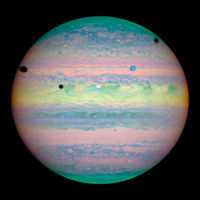
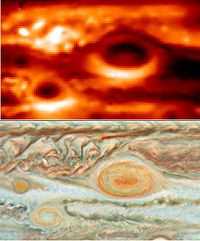
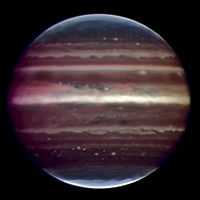
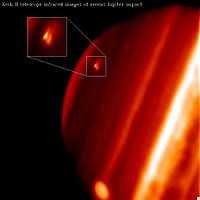

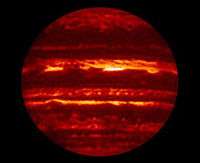
"Spectra from the Voyager I IRIS experiment confirm the existence of enhanced infrared emission near Jupiter's north magnetic pole in March 1979."[45] "Some species previously detected on Jupiter, including CH3D, C2H2, and C2H6, have been observed again near the pole. Newly discovered species, not previously observed on Jupiter, include C2H4, C3H4, and C6H6. All of these species except CH3D appear to have enhanced abundances at the north polar region with respect to midlatitudes."[45]
The image at third lower right is "of Jupiter taken in infrared light on the night of [August 17, 2008,] with the Multi-Conjugate Adaptive Optics Demonstrator (MAD) prototype instrument mounted on ESO's Very Large Telescope. This false color photo is the combination of a series of images taken over a time span of about 20 minutes, through three different filters (2, 2.14, and 2.16 microns). The image sharpening obtained is about 90 milli-arcseconds across the whole planetary disc, a real record on similar images taken from the ground. This corresponds to seeing details about 186 miles wide on the surface of the giant planet. The great red spot is not visible in this image as it was on the other side of the planet during the observations. The observations were done at infrared wavelengths where absorption due to hydrogen and methane is strong. This explains why the colors are different from how we usually see Jupiter in visible-light. This absorption means that light can be reflected back only from high-altitude hazes, and not from deeper clouds. These hazes lie in the very stable upper part of Jupiter's troposphere, where pressures are between 0.15 and 0.3 bar. Mixing is weak within this stable region, so tiny haze particles can survive for days to years, depending on their size and fall speed. Additionally, near the planet's poles, a higher stratospheric haze (light blue regions) is generated by interactions with particles trapped in Jupiter's intense magnetic field."[46]
The image at the top shows Jupiter in the near infrared. "Five spots -- one colored white, one blue, and three black are scattered across the upper half of the planet. Closer inspection by NASA's Hubble Space Telescope reveals that these spots are actually a rare alignment of three of Jupiter's largest moons -- Io, Ganymede, and Callisto -- across the planet's face. In this image, the telltale signatures of this alignment are the shadows [the three black circles] cast by the moons. Io's shadow is located just above center and to the left; Ganymede's on the planet's left edge; and Callisto's near the right edge. Only two of the moons, however, are visible in this image. Io is the white circle in the center of the image, and Ganymede is the blue circle at upper right. Callisto is out of the image and to the right. ... Jupiter appears in pastel colors in this photo because the observation was taken in near-infrared light. Astronomers combined images taken in three near-infrared wavelengths to make this color image. The photo shows sunlight reflected from Jupiter's clouds. In the near infrared, methane gas in Jupiter's atmosphere limits the penetration of sunlight, which causes clouds to appear in different colors depending on their altitude. Studying clouds in near-infrared light is very useful for scientists studying the layers of clouds that make up Jupiter's atmosphere. Yellow colors indicate high clouds; red colors lower clouds; and blue colors even lower clouds in Jupiter's atmosphere. The green color near the poles comes from a thin haze very high in the atmosphere. Ganymede's blue color comes from the absorption of water ice on its surface at longer wavelengths. Io's white color is from light reflected off bright sulfur compounds on the satellite's surface. ... In viewing this rare alignment, astronomers also tested a new imaging technique. To increase the sharpness of the near-infrared camera images, astronomers speeded up Hubble's tracking system so that Jupiter traveled through the telescope's field of view much faster than normal. This technique allowed scientists to take rapid-fire snapshots of the planet and its moons. They then combined the images into one single picture to show more details of the planet and its moons."[47]
"On July 19, 2009, a new black spot about the size of Earth was discovered in Jupiter's southern hemisphere by an amateur astronomer. Thermal infrared analysis showed it was warm and spectroscopic methods detected ammonia. JPL scientists confirmed that another impact event on Jupiter had occurred, probably a small undiscovered comet or other icy body.[48][7][49]"[50]
"These images [at right] show the distribution of the organic molecule acetylene at the north and south poles of Jupiter, based on data obtained by NASA's Cassini spacecraft in early January 2001. It is the highest-resolution map of acetylene to date on Jupiter. The enhanced emission results both from the warmer temperatures in the auroral hot spots, and probably also from an enhanced abundance in these regions. The detection helps scientists understand the chemical interactions between sunlight and molecules in Jupiter's stratosphere."[51]
The sixth image down on the right shows Jupiter in an infrared band where the Great Red Spot (on the lower left) is almost unseen.
Submillimeters
"[F]or wavelengths between 0.35 and 0.45 mm ... the radiances can be matched by models which include NH3 ice particles which are between 30 and 100 µm in size, regardless of the scale height characterizing the cloud."[52]
Radios
"In 1955, Bernard Burke and Kenneth Franklin detected bursts of radio signals coming from Jupiter at 22.2 MHz.[53] The period of these bursts matched the rotation of the planet, and they were also able to use this information to refine the rotation rate. Radio bursts from Jupiter were found to come in two forms: long bursts (or L-bursts) lasting up to several seconds, and short bursts (or S-bursts) that had a duration of less than a hundredth of a second.[54]"[10]
Forms of decametric radio signals from Jupiter:
- "bursts (with a wavelength of tens of meters) vary with the rotation of Jupiter, and are influenced by interaction of Io with Jupiter's magnetic field.[55]"[10]
- "emission (with wavelengths measured in centimeters) was first observed by Frank Drake and Hein Hvatum in 1959.[53] The origin of this signal was from a torus-shaped belt around Jupiter's equator. This signal is caused by cyclotron radiation from electrons that are accelerated in Jupiter's magnetic field.[56]"[10]
Between September and November 23, 1963, Jupiter is detected by radar astronomy.[57] "The dense atmosphere makes a penetration to a hard surface (if indeed one exists at all) very unlikely. In fact, the JPL results imply a correlation of the echo with Jupiter ... which corresponds to the upper (visible) atmosphere. ... Further observations will be needed to clarify the current uncertainties surrounding radar observations of Jupiter."[57] "Although in 1963 some claimed to have detected echoes from Jupiter, these were quite weak and have not been verified by later experiments."[58] "A search for radar echoes from Jupiter at 430 MHz during the oppositions of 1964 and 1965 failed to yield positive results, despite a sensitivity several orders of magnitude better than employed by other groups in earlier (1963) attempts at higher frequencies. ... [I]t might be suspected that meteorological disturbances of a random nature were involved, and that the echoes might be returned only in exceptional circumstances. Further support for this point of view may be gleaned from the fact that JPL found positive results for only 1 (centered at 32° System I longitude) of the 8 longitude regions investigated in 1963 (Goldstein 1964) and, in fact, had no success during their observations in 1964 (see comment by Goldstein following Dyce 1965)."[59]
Sun-Jupiter binary
The Sun-Jupiter binary may serve to establish an upper limit for interstellar cometary capture when three bodies are extremely unequal in mass, such as the Sun, Jupiter, and a third body (potential comet) at a large distance from the binary.[60] The basic problem with a capture scenario even from passage through “a cloud of some 10 million years, or from a medium enveloping the solar system, is the low relative velocity [~0.5 km s-1] required between the solar system and the cometary medium.”[61] The capture of interstellar comets by Saturn, Uranus, and Neptune together cause about as many captures as Jupiter alone.[61]
In a mechanism of chaos assisted capture (CAC), particles such as comets or those of sizes in the range of the irregular moons of Jupiter become entangled in chaotic layers which temporarily “extend the lifetimes of [these] particles within the Hill sphere, thereby providing the breathing space necessary for relatively weak dissipative forces (eg gas-drag) to effect permanent capture.”[62] These objects of the Sun-Jupiter binary system may localize near Jupiter and become satellites, specifically the irregular moons.[62]
Coronal clouds
"Because of an eccentricity of 0.048, the distance from Jupiter and the Sun varies by 75 million km between perihelion and aphelion, or the nearest and most distant points of the planet along the orbital path respectively."[10]
"Favorable oppositions occur when Jupiter is passing through perihelion, an event that occurs once per orbit. As Jupiter approached perihelion in March 2011, there was a favorable opposition in September 2010.[63]"[10]
It's orbital period is 4,332.59 d (11.8618 y).
"It is shown that starting with the alignment of Venus with Jupiter at perihelion position, these two planets will perfectly align at Jupiter's perihelion after every 23.7 years".[64]
"The tidal forces hypothesis for solar cycles has been proposed by Wood (1972) and others. Table 2 below shows the relative tidal forces of the planets on the sun. Jupiter, Venus, Earth and Mercury are called the "tidal planets" because they are the most significant. According to Wood, the especially good alignments of J-V-E with the sun which occur about every 11 years are the cause of the sunspot cycle. He has shown that the sunspot cycle is synchronous with the alignments, and J. Schove's data for 1500 year of sunspot maxima supports the 11.07 year J-V-E period average."[65]
"Both the 11.86 year Jupiter tropical period (time between perihelion's or closest approaches to the sun and the 9.93 year J-S alignment periods are found in sunspot spectral analysis. Unfortunately direct calculations of the tidal forces of all planets does not support the occurrence of the dominant 11.07 year cycle. Instead, the 11.86 year period of Jupiter's perihelion dominates the results. This has caused problems for several researchers in this field."[65]
The coronal cloud around Jupiter is exactly opposite to that around the Sun. At the Sun there are polar coronal holes, whereas at Jupiter the coronal cloud is most prevalent over the magnetic poles.
Astrognosy
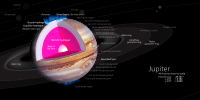
The model for the interior of Jupiter suggests the occurrence of such materials as metallic hydrogen.
Trojan asteroids
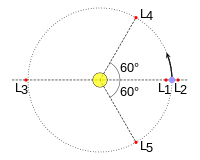
Def. "the L4 and L5 Lagrange points of the Sun-Jupiter orbital configuration"[66] are called the Trojan points.
Def. "an asteroid occupying the Trojan points of the Sun-Jupiter system"[67] is called a Trojan asteroid.
Planetary sciences
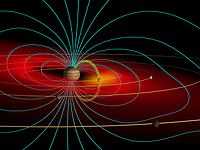
The image at right represents "[t]he Jovian magnetosphere [magnetic field lines in blue], including the Io flux tube [in green], Jovian aurorae, the sodium cloud [in yellow], and sulfur torus [in red]."[68]
"Io may be considered to be a unipolar generator which develops an emf [electromotive force] of 7 x 105 volts across its radial diameter (as seen from a coordinate frame fixed to Jupiter)."[69]
"This voltage difference is transmitted along the magnetic flux tube which passes through Io. ... The current [in the flux tube] must be carried by keV electrons which are electrostatically accelerated at Io and at the top of Jupiter's ionosphere."[69]
"Io's high density (4.1 g cm-3) suggests a silicate composition. A reasonable guess for its electrical conductivity might be the conductivity of the Earth's upper mantle, 5 x 10-5 ohm-1 cm-1 (Bullard 1967)."[69]
As "a conducting body [transverses] a magnetic field [it] produces an induced electric field. ... The Jupiter-Io system ... operates as a unipolar inductor" ... Such unipolar inductors may be driven by electrical power, develop hotspots, and the "source of heating [may be] sufficient to account for the observed X-ray luminosity".[70]
"The electrical surroundings of Io provide another energy source which has been estimated to be comparable with that of the [gravitational] tides (7). A current of 5 x 106 A is ... shunted across flux tubes of the Jovian field by the presence of Io (7-9)."[71]
"[W]hen the currents [through Io] are large enough to cause ohmic heating ... currents ... contract down to narrow paths which can be kept hot, and along which the conductivity is high. Tidal heating [ensures] that the interior of Io has a very low eletrical resistance, causing a negligible extra amount of heat to be deposited by this current. ... [T]he outermost layers, kept cool by radiation into space [present] a large resistance and [result in] a concentration of the current into hotspots ... rock resistivity [and] contact resistance ... contribute to generate high temperatures on the surface. [These are the] conditions of electric arcs [that can produce] temperatures up to ionization levels ... several thousand kelvins".[71]
"[T]he outbursts ... seen [on the surface may also be] the result of the large current ... flowing in and out of the domain of Io ... Most current spots are likely to be volcanic calderas, either provided by tectonic events within Io or generated by the current heating itself. ... [A]s in any electric arc, very high temperatures are generated, and the locally evaporated materials ... are ... turned into gas hot enough to expand at a speed of 1 km/s."[71]
Classical planets
"[O]range [is] the color of Jupiter"[37]
5102 b2k, -3102 or 3102 BC, is the historical year assigned to a Hindu table of planets that does include the classical planet Jupiter.[72] "Babylonian astronomy, too, had a four-planet system. In ancient prayers the planets Saturn, Jupiter, Mars, and Mercury are invoked; ... and one speaks of "the four-planet system of the ancient astronomers of Babylonia."[73]"[74]
~2800 b2k: “The observation of Jupiter dates back to the Babylonian astronomers of the 7th or 8th century BC.[75] ... To the Babylonians, this object represented their god Marduk. They used the roughly 12-year orbit of this planet along the ecliptic to define the constellations of their zodiac.[76][77]”[10].
2362 b2k: “The Chinese historian of astronomy, Xi Zezong, has claimed that Gan De, a Chinese astronomer, made the discovery of one of Jupiter's moons in 362 BC with the unaided eye. ... The Chinese, Korean and Japanese referred to the planet as the wood star”[10].
“The Greeks called it ... Phaethon, "blazing."”[10].
Erentüz
“In the Central Asian-Turkic myths, Jupiter called as a "Erendiz/Erentüz", which means "eren(?)+yultuz(star)". There are many theories about meaning of "eren". Also, these peoples calculated the orbit of Jupiter as 11 years and 300 days. They believed that some social and natural events connected to Erentüz's movements on the sky.[78]”[10].
Guru
“Hindu astrologers named the planet after Brihaspati, the religious teacher of the gods, and often called it "Guru", which literally means the "Heavy One."[79]”.[10]
Poeninus
"Mercury was the most honoured of all the gods and many images of him were to be found. Mercury was regarded as the inventor of all the arts, the patron of travellers and of merchants, and the most powerful god in matters of commerce and gain. After him, the Gauls honoured Apollo, who drove away diseases, Mars, who controlled war, Jupiter, who ruled the heavens, and Minerva, who promoted handicrafts. He adds that the Gauls regarded Dis Pater as their ancestor.[80] ... [The names of Roman gods] are coupled with native Celtic theonyms and epithets, such as Mercury Visucius, Lenus Mars, Jupiter Poeninus, or Sulis Minerva."[81]
Thor
“Thor [is] associated with the planet Jupiter in Germanic mythology.[82]”[10].
Tinia
"Tinia (also Tin, Tinh, Tins or Tina) was the god of the sky and the highest god in Etruscan mythology, equivalent to the Roman Jupiter and the Greek Zeus.[83]"[84]
Zeus
"In the ancient Greek religion, Zeus (Ancient Greek ... is the "Father of Gods and men" ... He is the god of sky and thunder in Greek mythology. His Roman counterpart is Jupiter and Etruscan counterpart is Tinia. ... Zeus is the child of Cronus and Rhea, and the youngest of his siblings. In most traditions he is married to Hera, although, at the oracle of Dodona, his consort is Dione: according to the Iliad, he is the father of Aphrodite by Dione."[85]
Observatory geology
.jpg)
Observatory geology has two forms:
- the geological study necessary to put an observatory on a solid foundation to maximize telescope function through minimizing ground-based vibration and
- imaging terrain by the observatory so that geological study may be performed.
"Images of Europa from the Galileo spacecraft [launch release at right from the shuttle Atlantis] show a surface with a complex history involving tectonic deformation, impact cratering, and possible emplacement of ice-rich materials and perhaps liquids on the surface. Differences in impact crater distributions suggest that some areas have been resurfaced more recently than others; Europa could experience current cryovolcanic and tectonic activity. Global-scale patterns of tectonic features suggest deformation resulting from non-synchronous rotation of Europa around Jupiter. Some regions of the lithosphere have been fractured, with icy plates separated and rotated into new positions. The dimensions of these plates suggest that the depth to liquid or mobile ice was only a few kilometers at the time of disruption. Some surfaces have also been upwarped, possibly by diapirs, cryomagmatic intrusions, or convective upwelling. In some places, this deformation has led to the development of chaotic terrain in which surface material has collapsed and/or been eroded"[86]
Planetary observatories
[Image:Tortugas Planetary Observatory.jpg|thumb|right|200px|This image is of the Tortugas Mountain Planetary Observatory taken on June 28, 2008. Credit: Jon Holtzman.]] "The 0.6m Tortugas Mountain Observatory is used to monitor the temporal changes in the Jovian cloud deck and equatorial activity on Saturn. The data are collected with a CCD camera, archived at the NMSU astronomy department and made available to the Astronomical community through the NASA Planetary Data System Subnode. Images collected over the last 27 years are being used as a climatic data base to interpret the Hubble Space Telescope ~HST!, Galileo and Cassini data. Although funding has been reduced, simultaneous observations are scheduled when the 3.5 meter telescope is used for infrared imaging of Jupiter."[87]
Research
Hypotheses:
- Certain conjunctions of Jupiter with Venus occur in the same cycle as the main Sun spot cycle.
- The conjunctions of Venus and Jupiter may be causing the Sunspot cycle as a result of enhanced electron flux to the Sun.
Control groups

The findings demonstrate a statistically systematic change from the status quo or the control group.
“In the design of experiments, treatments [or special properties or characteristics] are applied to [or observed in] experimental units in the treatment group(s).[88] In comparative experiments, members of the complementary group, the control group, receive either no treatment or a standard treatment.[89]"[90]
Proof of concept
Def. a “short and/or incomplete realization of a certain method or idea to demonstrate its feasibility"[91] is called a proof of concept.
Def. evidence that demonstrates that a concept is possible is called proof of concept.
The proof-of-concept structure consists of
- background,
- procedures,
- findings, and
- interpretation.[92]
See also
References
- ↑ P. Kenneth Seidelmann, B. A. Archinal, M. F. A'hearn, A. Conrad, G. J. Consolmagno, D. Hestroffer, J. L. Hilton, G. A. Krasinsky, G. Neumann (2007). "Report of the IAU/IAG Working Group on cartographic coordinates and rotational elements: 2006". Celestial Mechanics and Dynamical Astronomy 98 (3): 155-80. doi:10.1007/s10569-007-9072-y.
- ↑ P.C. Thomas, J.A. Burns, L. Rossier, D. Simonelli, J. Veverka, C.R. Chapman, K. Klaasen, T.V. Johnson, M.J.S. Belton, Galileo Solid State Imaging Team (September 1998). "The Small Inner Satellites of Jupiter". Icarus 135 (1): 360-71. doi:10.1006/icar.1998.5976. http://www.sciencedirect.com/science/article/pii/S0019103598959760. Retrieved 2012-06-01.
- ↑ Jennifer Blue (November 9, 2009). "Planet and Satellite Names and Discoverers". USGS. Retrieved 2010-01-13.
- ↑ D. P. Cruikshank and R. M. Nelson (2007). "A history of the exploration of Io". In Lopes, R. M. C.; and Spencer, J. R.. Io after Galileo. Springer-Praxis. pp. 5–33. ISBN 3-540-34681-3.
- ↑ "Io (moon), In: Wikipedia". San Francisco, California: Wikimedia Foundation, Inc. August 20, 2012. Retrieved 2012-09-23.
- ↑ Immanuel Velikovsky. "Uranus". The Immanuel Velikovsky Archive. Retrieved 2013-01-14.
- 1 2 Dennis Overbye (2009-07-24). "Hubble Takes Snapshot of Jupiter’s ‘Black Eye’". New York Times. Retrieved 2009-07-25.
- ↑ Lovett, Richard A. (December 15, 2006). "Stardust's Comet Clues Reveal Early Solar System". National Geographic News. Retrieved 2007-01-08.
- ↑ Nakamura, T.; Kurahashi, H. (1998). "Collisional Probability of Periodic Comets with the Terrestrial Planets: An Invalid Case of Analytic Formulation". Astronomical Journal 115 (2): 848–54. doi:10.1086/300206. http://www.iop.org/EJ/article/1538-3881/115/2/848/970144.html. Retrieved 2007-08-28.
- 1 2 3 4 5 6 7 8 9 10 11 12 13 14 15 16 17 "Jupiter, In: Wikipedia". San Francisco, California: Wikimedia Foundation, Inc. January 29, 2013. Retrieved 2013-02-16.
- ↑ Tabe, Isshi; Watanabe, Jun-ichi; Jimbo, Michiwo; Watanabe; Jimbo (February 1997). "Discovery of a Possible Impact SPOT on Jupiter Recorded in 1690". Publications of the Astronomical Society of Japan 49: L1–L5.
- 1 2 Franck Marchis (2012-09-10). "Another fireball on Jupiter?". Cosmic Diary blog. Retrieved 2012-09-11.
- ↑ Baalke, Ron. "Comet Shoemaker-Levy Collision with Jupiter". NASA. Retrieved 2007-01-02.
- ↑ Britt, Robert R. (August 23, 2004). "Remnants of 1994 Comet Impact Leave Puzzle at Jupiter". space.com. Retrieved 2007-02-20.
- 1 2 Staff (2009-07-21). "Amateur astronomer discovers Jupiter collision". ABC News online. Retrieved 2009-07-21.
- ↑ Salway, Mike (July 19, 2009). "Breaking News: Possible Impact on Jupiter, Captured by Anthony Wesley". IceInSpace. IceInSpace News. Retrieved 2009-07-19.
- ↑ Grossman, Lisa (July 20, 2009). "Jupiter sports new 'bruise' from impact". New Scientist.
- ↑ Bakich, Michael (2010-06-04). "Another impact on Jupiter". Astronomy Magazine online. Retrieved 2010-06-04.
- ↑ Beatty, Kelly (22 August 2010). "Another Flash on Jupiter!". Sky & Telescope. Sky Publishing. Retrieved 23 August 2010. "Masayuki Tachikawa was observing ... 18:22 Universal Time on the 20th ... Kazuo Aoki posted an image ... Ishimaru of Toyama prefecture observed the event"
- ↑ Hall, George (September 2012). "George's Astrophotography". Retrieved 17 September 2012. "10 Sept. 2012 11:35 UT .. observed by Dan Petersen"
- ↑ "Comet Shoemaker–Levy 9, In: Wikipedia". San Francisco, California: Wikimedia Foundation, Inc. February 15, 2013. Retrieved 2013-02-16.
- ↑ Barry H. Mauk and Joachim Saur (October 26, 2007). "Equatorial electron beams and auroral structuring at Jupiter". Journal of Geophysical Research 112 (A10221): 20. doi:10.1029/2007JA012370. http://www.agu.org/journals/ja/ja0710/2007JA012370/figures.shtml. Retrieved 2012-06-02.
- ↑ C. T. Russell, D. N. Baker and J. A. Slavin (January 1, 1988). Faith Vilas, Clark R. Chapman, Mildred Shapley Matthews. ed. The Magnetosphere of Mercury, In: Mercury. Tucson, Arizona, United States of America: University of Arizona Press. pp. 514-61. ISBN 0816510857. Bibcode: 1988merc.book..514R. http://books.google.com/books?id=hTvzWMjl_RYC&source=gbs_navlinks_s. Retrieved 2012-08-23.
- ↑ NASA/CXC/SWRI/G.R.Gladstone et al. (February 27, 2002). "Jupiter Hot Spot Makes Trouble For Theory". Cambridge, Massachusetts: Harvard-Smithsonian Center for Astrophysics. Retrieved 2012-07-11.
- ↑ X-ray: NASA/CXC/MSFC/R.Elsner et al.; Illustration: CXC/M.Weiss (March 2, 2005). "Jupiter: Chandra Probes High-Voltage Auroras on Jupiter". Cambridge, Massachusetts: Harvard-Smithsonian Center for Astrophysics. Retrieved 2012-07-11.
- ↑ "Ultraviolet, In: Wikipedia". San Francisco, California: Wikimedia Foundation, Inc. June 24, 2013. Retrieved 2013-06-30.
- ↑ T. E. Cravens (1987). "Vibrationally excited molecular hydrogen in the upper atmosphere of Jupiter". Journal of Geophysical Research 92 (A10): 11,083-100. doi:10.1029/JA092iA10p11083. http://www.agu.org/pubs/crossref/1987/JA092iA10p11083.shtml. Retrieved 2012-07-09.
- ↑ Space Telescope Image of Fragment BDGLNQ12R Impacts.jpg "File:Hubble Space Telescope Image of Fragment BDGLNQ12R Impacts.jpg". Wikimedia Commons (San Francisco, California: Wikimedia Foundation, Inc). October 31, 2010. http://commons.wikimedia.org/wiki/File:Hubble Space Telescope Image of Fragment BDGLNQ12R Impacts.jpg. Retrieved 2012-07-20.
- ↑ Zezong, Xi, "The Discovery of Jupiter's Satellite Made by Gan De 2000 years Before Galileo", Chinese Physics 2 (3) (1982): 664–67.
- ↑ "Naked eye in astronomy, In: Wikipedia". San Francisco, California: Wikimedia Foundation, Inc. June 3, 2012. Retrieved 2012-06-09.
- 1 2 Image Processing Laboratory (April 6, 2000). "PIA02257: Voyager 2 Jupiter Eruption Movie". Pasadena, California USA: NASA/JPL. Retrieved 2013-03-22.
- ↑ Voyager 1 team (February 9, 1979). "Jupiter, Io - Voyager 1". Greenbelt, Maryland USA: NASA Goddard Space Flight Center. Retrieved 2013-03-22.
- 1 2 3 Sue Lavoie (March 6, 1998). "PIA01195: Hazes near Jupiter's Limb (60 degrees North, 315 degrees West)". Pasadena, California USA: NASA/JPL. Retrieved 2013-04-01.
- 1 2 3 4 5 Sue Lavoie (December 28, 2000). "PIA02863: Planetwide Color Movie". Tucson, Arizona USA: NASA/JPL/University of Arizona. Retrieved 2013-05-30.
- ↑ "filters - popular and hot telescope filters". Lumicon international. Retrieved 2010-11-22.
- ↑ "Astronomical filter, In: Wikipedia". San Francisco, California: Wikimedia Foundation, Inc. 25 January 2013. Retrieved 2013-01-25.
- 1 2 Faber Birren (Summer 1983). "Color and human response". Color Research and Application 8 (2): 75-81. doi:10.1002/col.5080080204. http://onlinelibrary.wiley.com/doi/10.1002/col.5080080204/abstract. Retrieved 2012-04-23.
- ↑ Elkins-Tanton, Linda T. (2006). Jupiter and Saturn. New York: Chelsea House. ISBN 0-8160-5196-8.
- ↑ Strycker, P. D.; Chanover, N.; Sussman, M.; Simon-Miller, A. (2006). A Spectroscopic Search for Jupiter's Chromophores. American Astronomical Society. Bibcode: 2006DPS....38.1115S.
- ↑ Gierasch, Peter J.; Nicholson, Philip D. (2004). "Jupiter". World Book @ NASA. Retrieved 2006-08-10.
- ↑ Anonymous (August 10, 2000). "The Solar System – The Planet Jupiter – The Great Red Spot". Dept. Physics & Astronomy – University of Tennessee. Retrieved 2008-06-03.
- 1 2 "Atmosphere of Jupiter, In: Wikipedia". San Francisco, California: Wikimedia Foundation, Inc. June 27, 2012. Retrieved 2012-06-30.
- ↑ Fletcher, Leigh N.; Orton,, G.S.; Mousis et. al, O.; Yanamandra-Fisher, P.; Parrish, P.D.; Irwin, P.G.J.; Fisher, B.M.; Vanzi, L. et al. (2010). "Thermal structure and composition of Jupiter's Great Red Spot from high-resolution thermal imaging" (PDF). Icarus 208 (1): 306–328. doi:10.1016/j.icarus.2010.01.005. http://www.eso.org/public/archives/releases/sciencepapers/eso1010/eso1010.pdf.
- ↑ Beebe, R. (1997). Jupiter the Giant Planet (2nd ed.). Washington: Smithsonian Books. ISBN 1-56098-685-9. OCLC 224014042.
- 1 2 Sang J. Kim, John Caldwell, A.R. Rivolo, R. Wagener, Glenn S. Orton (November 1985). "Infrared polar brightening on Jupiter. III - Spectrometry from the Voyager 1 IRIS experiment". Icarus 64 (2): 233-48. doi:10.1016/0019-1035(85)90088-0. http://www.sciencedirect.com/science/article/pii/0019103585900880. Retrieved 2012-07-09.
- ↑ ESO/F. Marchis, M. Wong, E. Marchetti, P. Amico, S. Tordo (October 2, 2008). "Sharpening up Jupiter". ESO Santiago, Chile: ESO. Retrieved 2012-07-11.
- ↑ Phil Davis (May 3, 2011). "Triple Eclipse". National Aeronautics and Space Administration. Retrieved 2012-07-20.
- ↑ "Mystery impact leaves Earth-sized mark on Jupiter". CNN. July 21, 2009.
- ↑ Amateur astronomer spots Earth-size scar on Jupiter, Guardian, July 21, 2009
- ↑ "Impact event, In: Wikipedia". San Francisco, California: Wikimedia Foundation, Inc. September 5, 2012. Retrieved 2012-09-26.
- ↑ Sue Lavoie01 (December 31, 2010). "Acetylene at Jupiter's North and South Poles". Ministry of Space Exploration. Retrieved 2013-02-06.
- ↑ M.J. Griffin, P.A.R. Ade, G.S. Orton, E.I. Robson, W.K. Gear, I.G. Nolt, J.V. Radostitz (February-March 1986). "Submillimeter and millimeter observations of Jupiter". Icarus 65 (2-3): 244-56. doi:10.1016/0019-1035(86)90137-5. http://www.sciencedirect.com/science/article/pii/0019103586901375. Retrieved 2012-08-04.
- 1 2 Linda T. Elkins-Tanton (2006). Jupiter and Saturn. New York: Chelsea House. ISBN 0-8160-5196-8.
- ↑ Weintraub, Rachel A. (September 26, 2005). "How One Night in a Field Changed Astronomy". NASA. Retrieved 2007-02-18.
- ↑ Garcia, Leonard N. "The Jovian Decametric Radio Emission". NASA. Retrieved 2007-02-18.
- ↑ Klein, M. J.; Gulkis, S.; Bolton, S. J. (1996). "Jupiter's Synchrotron Radiation: Observed Variations Before, During and After the Impacts of Comet SL9". NASA. Retrieved 2007-02-18.
- 1 2 Gordon H. Pettengill & Irwin I. Shapiro (1965). "Radar Astronomy". Annual Review of Astronomy and Astrophysics 3: 377-410.
- ↑ Irwin I. Shapiro (March 1968). "Planetary radar astronomy". Spectrum, IEEE 5 (3): 70-9. doi:10.1109/MSPEC.1968.5214821. http://ieeexplore.ieee.org/xpls/abs_all.jsp?arnumber=5214821. Retrieved 2012-12-25.
- ↑ R. B. Dyce and G. H. Pettengill, and A. D. Sanchez (August 1967). "Radar Observations of Mars and Jupiter at 70 cm". The Astronomical Journal 72 (4): 771-7. doi:10.1086/110307. http://articles.adsabs.harvard.edu/cgi-bin/nph-iarticle_query?1967AJ.....72..771D&data_type=PDF_HIGH&whole_paper=YES&type=PRINTER&filetype=.pdf. Retrieved 2012-12-25.
- ↑ MJ Valtonen (February 1983). "On the capture of comets into the Solar System". The Observatory 103 (2): 1-4.
- 1 2 M. J. Valtonen; K. A. Innanen (April 1982). "The capture of interstellar comets". The Astrophysical Journal 255 (4): 307-15. doi:10.1086/159830.
- 1 2 Sergey A. Astakhov and David Farrelly (November 2004). "Capture and escape in the elliptic restricted three?body problem". Monthly Notices of the Royal Astronomical Society 354 (4): 971-9. doi:10.1111/j.1365-2966.2004.08280.x. http://arxiv.org/pdf/astro-ph/0408271. Retrieved 2012-03-12.
- ↑ Horizons output. "Favorable Appearances by Jupiter". Retrieved 2008-01-02. (Horizons)
- ↑ S.D. Verma (1986). K. B. Bhatnagar. ed. Influence of Planetary Motion and Radial Alignment of Planets on Sun, In: Space Dynamics and Celestial Mechanics. 127. Springer Netherlands. pp. 143-54. doi:10.1007/978-94-009-4732-0_13. ISBN 978-94-010-8603-5. http://link.springer.com/chapter/10.1007/978-94-009-4732-0_13. Retrieved 2013-07-07.
- 1 2 Ray Tomes (February 1990). Towards a Unified Theory of Cycles. Cycles Research Institute. pp. 21. http://cyclesresearchinstitute.org/cycles-general/tomes_unified_cycles.pdf. Retrieved 2013-07-07.
- ↑ 65.94.44.124 (11 December 2010). "Trojan point, In: Wiktionary". San Francisco, California: Wikimedia Foundation, Inc. Retrieved 2015-08-31.
- ↑ 65.94.44.124 (11 December 2010). "Trojan asteroid, In: Wiktionary". San Francisco, California: Wikimedia Foundation, Inc. Retrieved 2015-08-31.
- ↑ John Spencer (November 2000). "John Spencer's Astronomical Visualizations". Boulder, Colorado USA: University of Colorado. Retrieved 2013-04-05.
- 1 2 3 Peter Goldreich and Donald Lynden-Bell (April 1969). "Io, a jovian unipolar inductor". The Astrophysical Journal 156 (04): 59-78. doi:10.1086/149947.
- ↑ Kinwah Wu, Mark Cropper, Gavin Ramsay, and Kazuhiro Sekiguchi (March 2002). "An electrically powered binary star?". Monthly Notices of the Royal Astronomical Society 321 (1): 221-7. doi:10.1046/j.1365-8711.2002.05190.x.
- 1 2 3 Thomas Gold (November 1979). "Electrical Origin of the Outbursts on Io". Science 206 (4422): 1071-3. doi:10.1126/science.206.4422.1071.
- ↑ Jean Baptiste Joseph Delambre (1817). Histoire de l'astronomie ancienne. Paris: Courcier. pp. 639. http://books.google.com/books?id=2lVUjJSxjhQC&pg=PR3&source=gbs_selected_pages&cad=3#v=onepage&f=false. Retrieved 2012-01-13.
- ↑ Ernst Friedrich Weidner (1915). Handbuch der babylonischen Astronomie, Volume 1. J. C. Hinrichs. pp. 146. http://books.google.com/books?id=K6NDAAAAYAAJ&hl=en. Retrieved 2012-03-30.
- ↑ Immanuel Velikovsky (January 1965). Worlds in Collision. New York: Dell Publishing Co., Inc.. pp. 401. http://books.google.com/books?id=FJst27kSVBgC&pg=PA13&dq=%22Worlds+in+Collision%22+1965&hl=en. Retrieved 2012-01-13.
- ↑ A. Sachs (May 2, 1974). "Babylonian Observational Astronomy". Philosophical Transactions of the Royal Society of London (Royal Society of London) 276 (1257): 43–50 (see p. 44). doi:10.1098/rsta.1974.0008.
- ↑ Eric Burgess (1982). By Jupiter: Odysseys to a Giant. New York: Columbia University Press. ISBN 0-231-05176-X.
- ↑ Rogers, J. H. (1998). "Origins of the ancient constellations: I. The Mesopotamian traditions". Journal of the British Astronomical Association, 108: 9–28.
- ↑ "Türk Astrolojisi". ntvmsnbc.com. Retrieved 2010-04-23.
- ↑ "Guru". Indian Divinity.com. Retrieved 2007-02-14.
- ↑ Julius Caesar, Commentarii de Bello Gallico 6:17-18
- ↑ "Celtic pantheon, In: Wikipedia". San Francisco, California: Wikimedia Foundation, Inc. 27 June 2013. Retrieved 2013-06-27.
- ↑ Falk, Michael (1999). "Astronomical Names for the Days of the Week". Journal of the Royal Astronomical Society of Canada 93: 122–33. doi:10.1016/j.newast.2003.07.002.
- ↑ de Grummond, Etruscan Myth, Sacred History and Legend, page 53
- ↑ "Tinia, In: Wikipedia". San Francisco, California: Wikimedia Foundation, Inc. August 1, 2012. Retrieved 2012-09-09.
- ↑ "Zeus, In Wikipedia". San Francisco, California: Wikimedia Foundation, Inc. October 5, 2012. Retrieved 2012-10-15.
- ↑ Ronald Greeley, Robert Sullivan, James Klemaszewski, and Kim Homan, James W. Head III and Robert T. Pappalardo, Joseph Veverka and Beth E. Clark, Torrence V. Johnson and Kenneth P. Klaasen, Michael Belton, Jeffrey Moore and Erik Asphaug, Michael H. Carr, Gerhard Neukum and Tilmann Denk, Clark R. Chapman, Carl B. Pilcher, and Paul E. Geissler, R. Greenberg, and R. Tufts (September 1998). "Europa: Initial Galileo Geological Observations". Icarus 135 (1): 4-24. http://www.sciencedirect.com/science/article/pii/S0019103598959693. Retrieved 2013-12-09.
- ↑ A. Klypin (January 1996). "New Mexico State University, Department of Astronomy, Las Cruces, New Mexico 88003. Report for the year 1995.". Bulletin of the Astronomical Society 28 (1): 495-501. http://aas.org/archives/BAAS/v28n1/061601basr.pdf. Retrieved 2013-10-27.
- ↑ Klaus Hinkelmann, Oscar Kempthorne (2008). Design and Analysis of Experiments, Volume I: Introduction to Experimental Design (2nd ed.). Wiley. ISBN 978-0-471-72756-9. http://books.google.com/?id=T3wWj2kVYZgC&printsec=frontcover.
- ↑ R. A. Bailey (2008). Design of comparative experiments. Cambridge University Press. ISBN 978-0-521-68357-9. http://www.cambridge.org/uk/catalogue/catalogue.asp?isbn=9780521683579.
- ↑ "Treatment and control groups, In: Wikipedia". San Francisco, California: Wikimedia Foundation, Inc. May 18, 2012. Retrieved 2012-05-31.
- ↑ "proof of concept, In: Wiktionary". San Francisco, California: Wikimedia Foundation, Inc. November 10, 2012. Retrieved 2013-01-13.
- ↑ Ginger Lehrman and Ian B Hogue, Sarah Palmer, Cheryl Jennings, Celsa A Spina, Ann Wiegand, Alan L Landay, Robert W Coombs, Douglas D Richman, John W Mellors, John M Coffin, Ronald J Bosch, David M Margolis (August 13, 2005). "Depletion of latent HIV-1 infection in vivo: a proof-of-concept study". Lancet 366 (9485): 549-55. doi:10.1016/S0140-6736(05)67098-5. http://www.ncbi.nlm.nih.gov/pmc/articles/PMC1894952/. Retrieved 2012-05-09.
External links
| ||||||||||||||||||||||||||||||||||||||
| |||||||||||||||||||||||||||||||||||||||||
| |||||||||||||||||||||||||||||||||||||||||||||||||||||
![]() This is a research project at http://en.wikiversity.org
This is a research project at http://en.wikiversity.org
| |
Development status: this resource is experimental in nature. |
| |
Educational level: this is a research resource. |
| |
Resource type: this resource is an article. |
| |
Resource type: this resource contains a lecture or lecture notes. |
| |
Subject classification: this is an astronomy resource. |